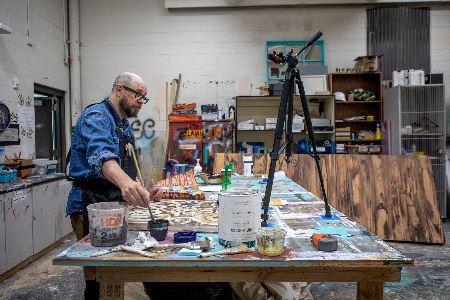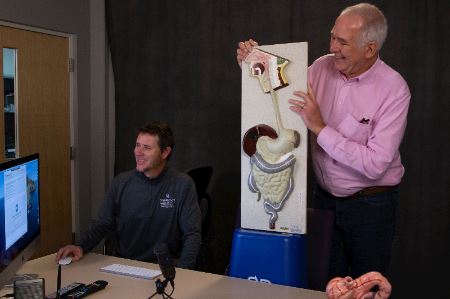WSU Faculty and Students Navigate New Normal
OGDEN, Utah – While the world battles with the COVID-19 pandemic, students and faculty at Weber State University have been adjusting to rapid changes and trying to find a new sense of normal amid a global crisis.
When Weber State made the decision to move the remainder of the spring semester to a virtual format on March 18, students were plunged into a new learning environment and faced uncertainty about their educational futures.
“The unknown is very scary at this time,” said Kiersten Cragun, a communication student with an emphasis in public relations and advertising. “Many of my classes have big group projects that were supposed to require in-person presentations. There were so many unknowns; it was hard not to get stressed.”
.jpg)
Nursing student Violet Lufkin studies at home.
Violet Lufkin, a first year nursing student, said the changes have been strange, but she has managed to make the necessary adjustments while still caring for her family’s needs.
“I have four kids, so in some ways my adjustments have been different than other students,” Lufkin said. “It has been a little easier because I don’t have to find child care, but on the other hand, my kids have school too. We have had to set some rules for study time, but they have adjusted fairly well. Luckily, this happened at the end of the semester, so I already knew how the nursing program works and what I needed to do. My professors have also been very understanding about the stress students are under and have tried to make things easier.”
Some students experienced anxiety over the possibility of failing classes because they relied on the in-class lectures and instruction to understand course material.
“It’s been stressful,” said Elise Weidman, a marketing major in the John B. Goddard School of Business & Economics. “Learning the information that was previously given to me in a face-to-face lecture has been difficult because I relied heavily on in-person contact.”
Although she dropped one of her classes, Weidman is now doing well in her remaining courses and, with the help of her professors, has been able to adjust to the virtual learning environment.

Cully Long teaches his Scenic Painting class with an iPhone.
Faculty also faced their own challenges. In a matter of days, faculty were tasked with moving all their face-to-face courses online. They tried to make the transition as smooth as possible by adjusting course due dates, changing testing formats, teaching online lectures in everything from art to nursing to zoology. Faculty offered virtual office hours to help students make it through the semester.
“I’ve tried to keep in mind that, not only is my life up in the air now, so are my students' lives,” said Andrew Keinsley, economics assistant professor. “The environment is different, so we should treat it as such. It’s important to realize I probably shouldn't try to make everything exactly the same as a normal class.”
Despite challenges, some professors have already seen positive responses to the changes from their students. Communication professor Susan Hafen said her students have been engaging in discussions more than they would in a face-to-face class.
“Because the students had already had eight weeks to get to know each other, they seem more willing to engage in group discussions,” Hafen said. “Their responses to questions and each other are far more thoughtful than in class. They are having to do more reading and fully watch the videos, in order to answer the questions. In class, I only hear from a few students, and often the same ones. Now I am hearing from all of them, and I am delighted with their engagement with each other.”
As the situation evolves, students continue doing their best to find ways to adjust and manage their anxiety in the new reality. Some have implemented strategies such as making schedules, writing down important announcements, taking time for naps, reaching out for support from friends and family, and even doing yoga.
“I am trying my absolute best to remain positive,” said Clarissa Marston, a psychology and neuroscience major. “I am trying to be grateful for my health and for the other things I am fortunate enough to not worry about. I am also trying to make sure to keep a schedule going and maintaining routines to the best of my ability. I think even getting up and making sure I get dressed in the morning helps things to feel somewhat normal.”

Jim Hutchins (right) instructs students online with the help of Ryan Belnap.
While transitioning courses online, faculty have also been working hard to help ease student fears and provide additional support for students to ensure they can finish the semester successfully.
“I've been managing, or trying to manage, student stress,” said Jim Hutchins, health sciences professor. “Students are so scared right now. I try to make sure they know that we care about them; we are on their side, and we can be flexible in the current emergency. We are all in this together and will get through it together.”
As a new type of normal begins to set in, students and faculty are striving to stay strong and continue doing their best to remain positive about the future.
“I feel hopeful that even though things are pretty bad right now, we will all be OK,” said Joshua Anderson, a communication major with an emphasis in public relations and advertising. “It will take effort, adaptability and cooperation, but things are going to be OK. Happiness is not outside our reach in this or any other moment. We just have to look for it.”
Visit weber.edu/wsutoday for more news about Weber State University.
Shaylee Stevens, Office of Marketing & Communications
801-626-7948 • shayleestevens@weber.edu- Contact:
Allison Barlow Hess, Public Relations director
801-626-7948 • ahess@weber.edu